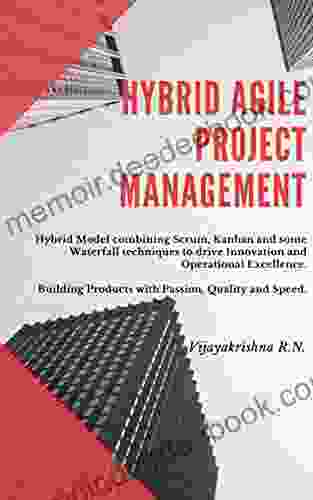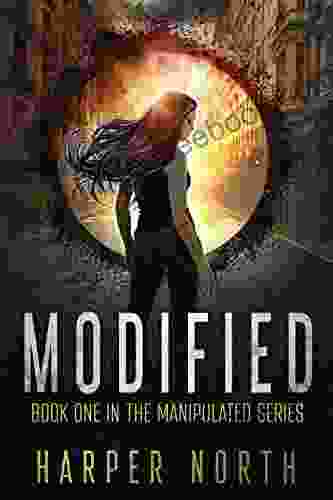Hybrid Model Combining Scrum, Kanban, and Waterfall Techniques: A Driving Force for Project Success

In the dynamic and ever-evolving world of project management, organizations strive to find the most effective methodologies to deliver exceptional results. While traditional methodologies like Waterfall have their strengths, they often fall short in addressing the complexities and uncertainties of modern projects. This has led to the emergence of agile methodologies such as Scrum and Kanban, which offer greater flexibility and adaptability. However, even these methodologies may not be sufficient to cater to the diverse needs of all projects.
To address this gap, project managers have begun to explore hybrid models that combine elements from different methodologies. One such hybrid model is the integration of Scrum, Kanban, and some Waterfall techniques, which has proven to be a powerful approach for driving project success. This article delves into the benefits, implementation, and best practices of this hybrid model, providing insights into how it can enhance project outcomes.
4.1 out of 5
| Language | : | English |
| File size | : | 3525 KB |
| Text-to-Speech | : | Enabled |
| Screen Reader | : | Supported |
| Enhanced typesetting | : | Enabled |
| Print length | : | 79 pages |
| Lending | : | Enabled |
| X-Ray for textbooks | : | Enabled |
| Paperback | : | 30 pages |
| Item Weight | : | 1 pounds |
| Dimensions | : | 6 x 0.85 x 9 inches |
| Hardcover | : | 216 pages |
Benefits of a Hybrid Scrum-Kanban-Waterfall Model
The combination of Scrum, Kanban, and Waterfall techniques offers a unique set of benefits that make it an ideal choice for projects facing challenges such as changing requirements, tight deadlines, and resource constraints. These benefits include:
Increased Flexibility and Adaptability
The Scrum framework provides a structured approach to project planning and execution, while Kanban allows for continuous flow and visualization of work. The integration of Waterfall techniques, such as upfront requirements gathering and documentation, ensures that critical project aspects are thoroughly planned and executed. This combination enables teams to respond quickly to changing requirements and adapt to unforeseen circumstances.
Improved Communication and Collaboration
Scrum's emphasis on daily stand-up meetings and retrospectives fosters regular communication and collaboration among team members. Kanban's visual representation of work promotes transparency and facilitates effective cross-functional collaboration. The inclusion of Waterfall techniques, such as formal requirements specifications and design documents, ensures that all project stakeholders are aligned and have a clear understanding of project goals.
Enhanced Risk Management
Waterfall's structured approach to requirements gathering and risk identification helps teams to proactively identify and mitigate potential risks. Scrum's iterative and incremental development process allows for early detection of issues and provides opportunities to make adjustments before they become major roadblocks. This combination of techniques enhances the overall risk management process and increases the likelihood of project success.
Increased Productivity and Efficiency
Kanban's focus on continuous flow and work-in-progress limits helps teams to optimize their workflow and improve productivity. Scrum's emphasis on short sprints and regular retrospectives enables teams to identify and eliminate bottlenecks, leading to greater efficiency. The integration of Waterfall techniques, such as detailed planning and documentation, ensures that projects are executed with precision and clarity, minimizing rework and delays.
Implementation of a Hybrid Scrum-Kanban-Waterfall Model
To successfully implement a hybrid Scrum-Kanban-Waterfall model, it is essential to carefully consider the project's unique requirements and tailor the approach accordingly. Here are some key steps to follow:
1. Define Project Scope and Requirements
Begin by clearly defining the project's scope and requirements using Waterfall techniques. This includes gathering detailed user stories, functional specifications, and non-functional requirements. This upfront planning ensures that all stakeholders have a shared understanding of the project's objectives.
2. Create a Scrum Framework
Establish a Scrum framework by defining sprints, sprint goals, and product backlogs. Use Scrum's iterative and incremental approach to break down the project into smaller, manageable tasks. This allows for continuous delivery of value and early feedback from stakeholders.
3. Implement Kanban Workflows
Introduce Kanban workflows to visualize work and manage flow. Create a Kanban board with columns representing different stages of the development process, such as "To Do," "In Progress," and "Done." Use sticky notes or digital cards to represent work items and track their progress through the board.
4. Integrate Waterfall Techniques
Incorporate selected Waterfall techniques where appropriate. For example, use Waterfall to conduct thorough requirements gathering, create detailed design specifications, or perform formal testing and quality assurance. This ensures that critical project aspects are planned and executed with precision.
5. Continuously Monitor and Adjust
Regularly monitor project progress and gather feedback from stakeholders. Use Scrum retrospectives to identify areas for improvement and adjust the hybrid model as needed. This continuous monitoring and adjustment process ensures that the model remains effective and aligned with the project's evolving needs.
Best Practices for a Hybrid Scrum-Kanban-Waterfall Model
To maximize the effectiveness of a hybrid Scrum-Kanban-Waterfall model, it is recommended to adhere to the following best practices:
1. Use a Phased Approach
Adopt a phased approach by dividing the project into distinct stages. Each stage can follow a different methodology, such as Waterfall for upfront planning, Scrum for development, and Kanban for continuous improvement. This approach ensures that the most appropriate techniques are applied at each project stage.
2. Foster Collaboration and Communication
Encourage open communication and collaboration among team members, stakeholders, and customers. Regular meetings, shared documentation, and transparent work practices facilitate alignment and reduce misunderstandings. This collaborative environment enables teams to adapt quickly to changing requirements and deliver successful outcomes.
3. Embrace Lean Principles
Adopt lean principles to minimize waste and optimize the workflow. Use Kanban's work-in-progress limits to prevent bottlenecks and promote continuous flow. Regularly review and refine processes to identify and eliminate non-value-added activities. This lean approach enhances efficiency and productivity.
4. Provide Training and Support
Ensure that all team members receive adequate training and support to understand and effectively implement the hybrid model. This includes training on Scrum, Kanban, Waterfall techniques, and the specific tools and practices used in the project context. Training empowers teams to leverage the model's full potential.
5. Continuously Evaluate and Improve
Continuously evaluate the effectiveness of the hybrid model and make adjustments as needed. Use metrics, such as velocity, lead time, and defect rates, to track progress and identify areas for improvement. Regular retrospectives and feedback sessions provide valuable insights for optimizing the model and maximizing project outcomes.
The hybrid model that combines Scrum, Kanban, and Waterfall techniques offers a powerful approach for driving project success. By leveraging the strengths of each methodology, this model provides increased flexibility, improved communication, enhanced risk management, and increased productivity. Through careful implementation and adherence to best practices, project managers can harness the full potential of this hybrid model to deliver exceptional results and achieve project goals. As the project landscape continues to evolve, hybrid models will play an increasingly significant role in empowering teams to navigate complex and demanding project environments.
4.1 out of 5
| Language | : | English |
| File size | : | 3525 KB |
| Text-to-Speech | : | Enabled |
| Screen Reader | : | Supported |
| Enhanced typesetting | : | Enabled |
| Print length | : | 79 pages |
| Lending | : | Enabled |
| X-Ray for textbooks | : | Enabled |
| Paperback | : | 30 pages |
| Item Weight | : | 1 pounds |
| Dimensions | : | 6 x 0.85 x 9 inches |
| Hardcover | : | 216 pages |
Do you want to contribute by writing guest posts on this blog?
Please contact us and send us a resume of previous articles that you have written.
 Chapter
Chapter Story
Story Library
Library E-book
E-book Magazine
Magazine Newspaper
Newspaper Sentence
Sentence Bookmark
Bookmark Shelf
Shelf Foreword
Foreword Preface
Preface Synopsis
Synopsis Scroll
Scroll Tome
Tome Classics
Classics Library card
Library card Biography
Biography Autobiography
Autobiography Reference
Reference Encyclopedia
Encyclopedia Thesaurus
Thesaurus Narrator
Narrator Borrowing
Borrowing Stacks
Stacks Archives
Archives Study
Study Lending
Lending Reserve
Reserve Academic
Academic Journals
Journals Reading Room
Reading Room Special Collections
Special Collections Interlibrary
Interlibrary Literacy
Literacy Thesis
Thesis Dissertation
Dissertation Storytelling
Storytelling Reading List
Reading List Book Club
Book Club Textbooks
Textbooks Kehinde Andrews
Kehinde Andrews David Ellefson
David Ellefson Shannon Humphrey
Shannon Humphrey Pets Unchained
Pets Unchained Fredric Jameson
Fredric Jameson Janice Irwin
Janice Irwin Karim Valji
Karim Valji J Bruce Jones
J Bruce Jones Daniel Waitzman
Daniel Waitzman Ted Cruz
Ted Cruz William Jiang
William Jiang Juliet Foster
Juliet Foster Christopher Ali
Christopher Ali Andrew L Seidel
Andrew L Seidel Pietro Bartolo
Pietro Bartolo Guido Bonsaver
Guido Bonsaver Vivien Prideaux
Vivien Prideaux Ivanil Nunes
Ivanil Nunes Gerald Mast
Gerald Mast Emily J Dolbear
Emily J Dolbear
Light bulbAdvertise smarter! Our strategic ad space ensures maximum exposure. Reserve your spot today!

 Carlos DrummondCurious George in the Big City: A Nostalgic Journey into Childhood Adventure
Carlos DrummondCurious George in the Big City: A Nostalgic Journey into Childhood Adventure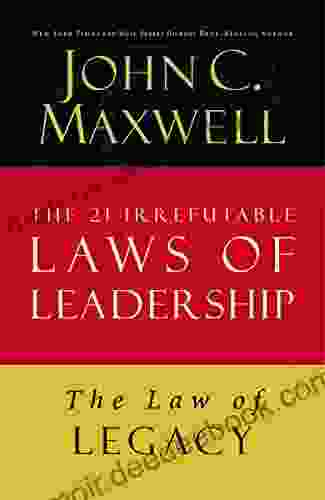
 Cormac McCarthyLesson 21 from The 21 Irrefutable Laws of Leadership: The Law of Empowerment
Cormac McCarthyLesson 21 from The 21 Irrefutable Laws of Leadership: The Law of Empowerment
 Efrain PowellSpring Novel Seasonal Quartet: A Captivating Exploration of Human Nature and...
Efrain PowellSpring Novel Seasonal Quartet: A Captivating Exploration of Human Nature and... Ralph TurnerFollow ·10.6k
Ralph TurnerFollow ·10.6k Derrick HughesFollow ·12.2k
Derrick HughesFollow ·12.2k Julio CortázarFollow ·10.3k
Julio CortázarFollow ·10.3k Adrien BlairFollow ·7.9k
Adrien BlairFollow ·7.9k Dean CoxFollow ·6.3k
Dean CoxFollow ·6.3k Nathaniel PowellFollow ·14.1k
Nathaniel PowellFollow ·14.1k Gilbert CoxFollow ·12.1k
Gilbert CoxFollow ·12.1k Jason HayesFollow ·5.3k
Jason HayesFollow ·5.3k

 Vernon Blair
Vernon BlairHow to Get a Woman to Pay for You: A Comprehensive Guide...
In the modern dating...

 Levi Powell
Levi PowellPrinciples and Theory for Data Mining and Machine...
Data mining and machine learning are two...
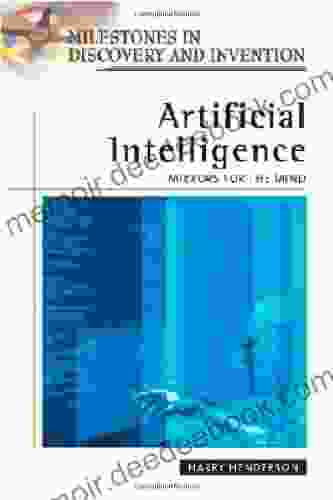
 Andrew Bell
Andrew BellMirrors For The Mind: Milestones In Discovery And...
Mirrors have been a part of human history...
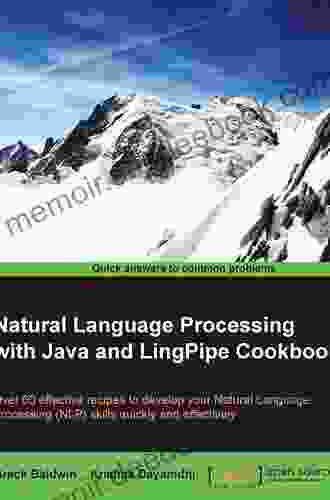
 Alec Hayes
Alec HayesDelving into Natural Language Processing with Java and...
Natural Language Processing (NLP) is an...
4.1 out of 5
| Language | : | English |
| File size | : | 3525 KB |
| Text-to-Speech | : | Enabled |
| Screen Reader | : | Supported |
| Enhanced typesetting | : | Enabled |
| Print length | : | 79 pages |
| Lending | : | Enabled |
| X-Ray for textbooks | : | Enabled |
| Paperback | : | 30 pages |
| Item Weight | : | 1 pounds |
| Dimensions | : | 6 x 0.85 x 9 inches |
| Hardcover | : | 216 pages |


